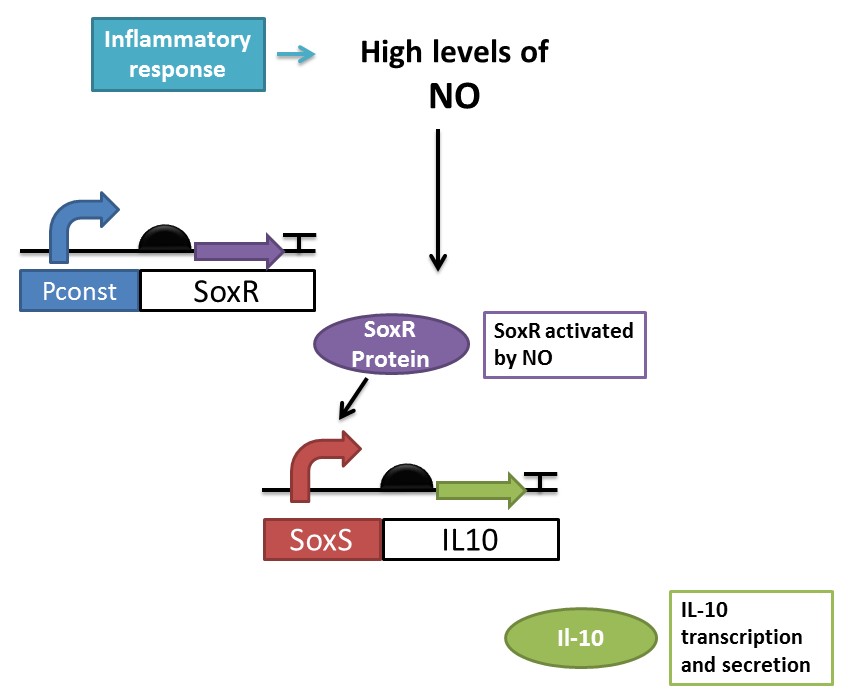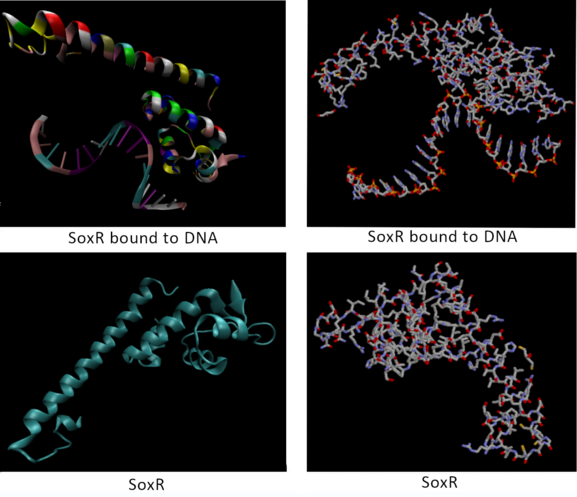Part:BBa_K554003
SoxR
SoxR is a transcription factor found in bacteria and is activated during superoxide or nitric oxide stress. SoxR protein in solution is a homodimer that contains two binuclear iron–sulfur clusters ([2Fe–2S]) which are then oxidized upon superoxide stress. In this form, the protein induces transcription through binding at SoxS promoter. Thus, in the presence of NO, SoxR activates transcription of the gene regulated by SoxS promoter (Hidalgo et al, 1998).
Sequence and Features
- 10COMPATIBLE WITH RFC[10]
- 12COMPATIBLE WITH RFC[12]
- 21COMPATIBLE WITH RFC[21]
- 23COMPATIBLE WITH RFC[23]
- 25COMPATIBLE WITH RFC[25]
- 1000COMPATIBLE WITH RFC[1000]
Usage and Biology
The [2Fe-2S] SoxR transcription factor a member of MerR family and is an important sensor of oxidative stress in bacteria, turning activated under presence of superoxide and nitric oxide (NO). SoxR is activated by reversible one-electron oxidation of its [2Fe-2S] cluster and in the active state, SoxR activate transcription of genes containing SoxS promoter, which have a long 19- or 20-bp spacer between the -35 and -10 operator elements, by untwisting the promoter DNA (Watanabe et al. 2008). The SoxR gene is used by [http://2011.igem.org/Team:UNICAMP-EMSE_Brazil UNICAMP-EMSE Brazil team] in the [http://2011.igem.org/Team:UNICAMP-EMSE_Brazil/Project#Device_2:_NO_sensor.2FIL-10_producer NO sensor device/ IL-10 producer] ("Device 2", which senses NO levels and responds by producing and secreting IL-10). This part is shown in the following schema:
Three-dimensional structure representation
You can find below a tridimensional structure of Escherichia coli SoxR protein bound to SoxS promoter (DNA structure) (retrieved from PDB 2zhg, Watanabe et al. 2008). This is a jmol applet, in which you can interactively see part of the SoxS promoter bound to its regulatory protein SoxR in a 3D manner:
MIT_MAHE 2020
Usage and Biology
The soxRS regulon consists of at least 14 genes. Along with functions that eliminate the cause of oxidative stress, repair or compensate for damage, metabolic functions are induced that enable the cells to cope with the oxidative stress.
The O2 - (superoxide) radical is an ion that penetrates membranes poorly. However, other biologically generated radicals, most notably nitric oxide (NO'), do cross lipid bilayers. NO is generated in short bursts for intercellular signaling, or in a more sustained fashion by some immune cells as a cytotoxic weapon (Nathan and Xie, 1994). We found recently (Nunoshiba et al., 1993) that acute exposure to pure NO" activates the soxRS regulon in a manner independent from O2-, and that the soxRS regulon provides a survival advantage for E. coli after phagocytosis by murine macrophages. This increased survival was seen only after > 4 h of phagocytosis when NO is being generated at a high rate (Nathan and Xie, 1994).
Only Fe-SoxR stimulated transcription in vitro from the soxS promoter, up to 100-fold over the basal transcription seen with RNAP alone. These observations led to the current model for soxRS regulation in vivo (Hidalgo and Demple, 1996b). In this model, the first step in this two-stage transcriptional cascade involves the NO•- or O2• mediated activation of pre-existing SoxR, by a mechanism that could involve both insertions of the iron-sulfur centers and their oxidation (Hidalgo et al., 1995; Hidalgo and Demple, 1996a). Activated, Fe-SoxR then induces transcription of the soxS gene. The limiting step in this transcription activation event would not be the binding of SoxR to the soxS promoter, but an allosteric effect that promotes open complex formation by RNAP (Hidalgo et al., 1995).
Studies showed that the 19 bp spacing is required for effective SoxR-mediated activation and that this unusually long distance prevents SoxR from being a repressor.
Previous studies demonstrated the ability of FeSoxR to activate transcription in vitro from a 180 bp wildtype promoter sequence (Hidalgo et al., 1995). A similar analysis of the 149 bp promoter fragments using primer extension with a new oligonucleotide was carried out to quantify the amount of soxS transcript synthesized in the reactions. Plasmids pEH44 (wild-type, 19 bp spacing; series 40) or pEH55 (1 bp deletion, 18 bp spacing; series 50) were incubated with RNAP alone or with the active Fe-SoxR or the inactive apo-SoxR. The results demonstrate that, although Fe-SoxR was required for activation of transcription from the wild-type promoter, active SoxR was not required for transcription from the 18 bp spacing mutant promoter. Although apo- SoxR did not affect transcription from the pEH55 promoter detectably, there was slight activation by Fe-SoxR.
References
Watanabe S, Kita A, Kobayashi K, Miki K. Crystal structure of the [2Fe-2S] oxidative-stress sensor SoxR bound to DNA.Proc Natl Acad Sci U S A. 2008 Mar 18;105(11):4121-6. Epub 2008 Mar 11. [http://www.ncbi.nlm.nih.gov/pubmed/18334645 Link to PubMed]
Hidalgo E, Leautaud V, Demple B (1998) The redox-regulated SoxR protein acts from a single DNA site as a repressor and an allosteric activator. The EMBO Journal 17(9)2629–2636 [http://www.ncbi.nlm.nih.gov/pubmed/?term=9564045%20 Link to Pubmed]
Nunoshiba, T., Hidalgo, E., Amábile Cuevas, C. F., & Demple, B. (1992). Two-stage control of an oxidative stress regulon: the Escherichia coli SoxR protein triggers redox-inducible expression of the soxS regulatory gene. Journal of bacteriology, 174(19), 6054–6060. https://doi.org/10.1128/jb.174.19.6054-6060.1992
Demple B. (1996). Redox signaling and gene control in the Escherichia coli soxRS oxidative stress regulon--a review. Gene, 179(1), 53–57. https://doi.org/10.1016/s0378-1119(96)00329-0
Hidalgo, E., & Demple, B. (1997). Spacing of promoter elements regulates the basal expression of the soxS gene and converts SoxR from a transcriptional activator into a repressor. The EMBO journal, 16(5), 1056–1065. https://doi.org/10.1093/emboj/16.5.1056
Wu, J., & Weiss, B. (1992). Two-stage induction of the soxRS (superoxide response) regulon of Escherichia coli. Journal of bacteriology, 174(12), 3915–3920. https://doi.org/10.1128/jb.174.12.3915-3920.1992
Touati D. (2000). Sensing and protecting against superoxide stress in Escherichia coli--how many ways are there to trigger soxRS response?. Redox report : communications in free radical research, 5(5), 287–293. https://doi.org/10.1179/135100000101535825
Structure: https://www.rcsb.org/structure/2ZHH
https://www.rcsb.org/structure/2ZHG| None |


